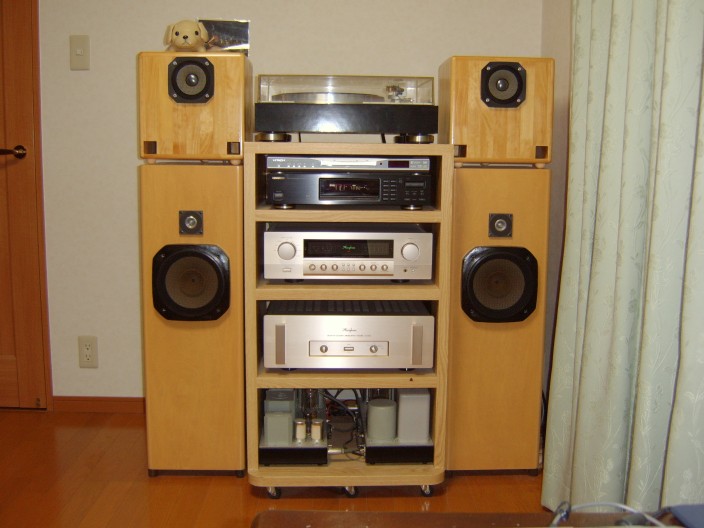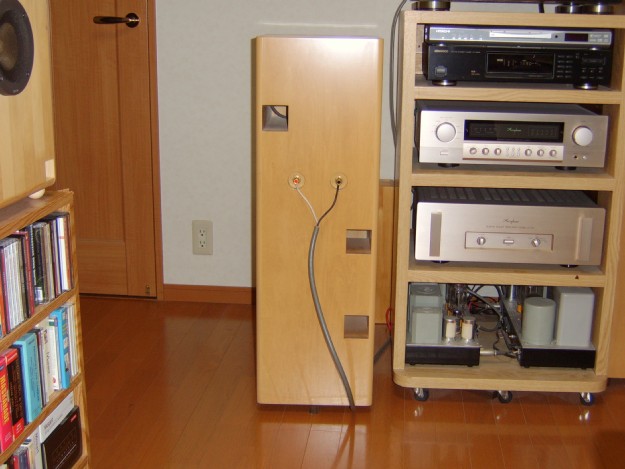Yahoo! Geocities is going to stop web server service. This page is moved to another page.
All the updates is in new page.
Click here to go to new page.
2. Advantages of MCAP-CR
3. Principle of MCAP-CR
4. Application Samples
5. MCAP-CR with Feastrex driver
6. Appendices
| Items | Link |
| Theory of MCAP-CR | Calculation Details (PDF in English) |
| Basic concept of MCAP-CR | Concept of MCAP Cavity Resonator (PDF in English) |
| Simplified calclation approach to estomate characteristic frequencies without eigen value theory | Simpler Method to Estimate Characteristic Frequencies of MCAP Cavity Resonator (PDF in English) |
| Calculation tool to estimate characteristic frequencies based on above simplification approach | Simplified Calculation Sheet (Microsoft Excel file) |
| New! Suggested Cabinet for 4.5" - 5" drivers TR120b. |
1. Overview
MCAP-CR is an extended application of bass-reflex speaker enclosure. MCAP-CR stands for Multiple-Chamber Aligned in Parallel Cavity Resonator.
MCAP-CR is true multiple degree of freedom cavity resonator application. An MCAP-CR generates very low frequency sound pressure in considerablly high level. You may design MCAP-CR to considerably small size. You will find applications here.
MCAP-CR is developed by myself and patent application was submitted to Japan Patent Office in March 2007, yet there is no limitation to use the idea for non-commercial personal use.
You may flexiblly design your own MCAP enclosure by yourself. MCAP-CR is somewhat more complicated than simple bass-reflex enclosure, but easier to assemble than back-loaded horn systems.
You may ask me any questions, if you have interested in this system and want to know more.
My email address is "mcapspeakers @ gmail.com". Please remove spaces of both sides of @ from the email address. These spaces are intended to protect from SPAM.
Sincerely,
Shigeru Suzuki
2. Advantages of MCAP-CR
MCAP-CR has multiple characteristic frequency. This realizes flat response over the low frequency range.
Characteristics below may be stressed:
(Characterstics of Sound)
- Frequency of lowest end is generally lower than other enclosure types like back-loaded horn or bass-reflex systems, if total size is equivalent.
- Sond character is similar to bass-reflex system, rather than back-loaded horn or pipe resonator systems.
(Characteristics of Structure)
- There are chambers in the enclosure.
- There are separation walls in the enclosure. These walls make the enclosure stiffer.
- Speaker driver is installed in the main chamber and sub-chambers are connected to main chamber by inter-chamber ducts.
- At least one of the subchambers have open-air duct.
3. Principle of MCAP-CR
We may note that MCAP-CR is an application of bass-reflex enclosure. We need to understand how bass-reflex enclosure works.
Principle of Bass-Reflex Enclosure
Fig.1 shows equivalent model of Bass-Reflex enclosure or cavity resonator. This is just a simple vibration model. You may have learned in high school or college. Simple vibration generally has single characteristic frequency.
Fig.1 Equivalent Model of Bass-Reflex Enclosure
Characteristic frequency of this model is expressed as:
fD = 1/2π*(k/m)1/2
where,fD : Characteristic frequency of duct mass
k : Stiffness of air in the chamber for the duct
m : Mass of air involved in the duct
Refer to detailed calculation document here.
Fig.2 shows double-bass-reflex enclosure. Please note that double-bass-reflex enclosure has two masses in the system.
Fig.2 Equivalent Model of Double-Bass-Reflex Enclosure
Fig.2 shows equivalent model of double-bass-reflex enclosure. Double-bass-reflex model is a coupled oscillation model. Calculating characteristic frequencies of this two degree of freedom oscillation model is not difficult. We do not need computer programme to solve this model. Refer to Appendix-1 of MCAP006E for more details.
Double-bass-reflex model can be extended to triple, quadraple, and even more multiple-bass-reflex models. Fig.3 shows quadraple bass-reflex enclosure model.
Fig.3 Equivalent Model of Quadraple-Bass-Reflex Enclosure
Multiple-Bass-Reflex Model to MCAP-CR Model
MCAP-CR is different from Multiple-Bass-Reflex noted above. MCAP-CR consists of a main chamber and sub-chambers. Sub-chambers are connected in parallel. This is the main difference from Multiple-Bass-Reflex enclosure.
Fig.4 shows schematics of MCAP-CR model. This schematics has four sub-chambers as an example. Number of sub-chambers is unlimited.
Fig. 4 Schematics of MCAP-CR
In this case, number of ducts are eight, so number of characteristic frequencies is up to eight. We may design this cavity resonator to have unique characteristic frequencies, so, in general. Number of characteristic frequency is same as number of ducts.
Please refer to MCAP001E for more details.
You may read simplified calculation approach explained here.
You will find an application example of MCAP-CR below.
Fig. 5 An application example of MCAP-CR
Fig.5 shows an example application of MCAP-CR. There are three sub-chambers and six ducts, and it configures six degree of freedom cavity resonator. This was designed for 8" driver Fostex FE206E, but later modified for Feastrex 5"driver.

Applications of MCAP-CRs
This picture shows two applications of MCAP-CRs, respectively, 4.5" driver and 8" drivers. These application seems standard bass-reflex or sealed cavinets.

Rear Side of MCAP-CR 8" application
This is rear side of 8" MCAP-CR system. You will see three ducts in the rear side. Three more ducts are hidden in inside the enclosure as shown in Fig.5.
You will ask "where is the woofer?" if you hear the soud of MCAP-CRs. You will not believe that these are full-range driver systems until you hear the sound. You should try MCAP-CR if you do not believe this fact.